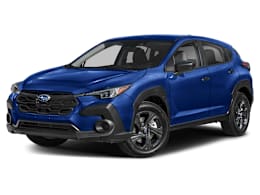The Subaru Crosstrek is one of the most researched cars on ConsumerReports.org, and for good reason: It delivers an excellent ride, good fuel economy, standard all-wheel drive, and enough ground clearance for mild off-roading all in a reasonably sized and priced package. We wish the base engine didn’t feel so feeble or get so loud, but, otherwise, the well-rounded Crosstrek is currently the highest scoring subcompact SUV.
This category is absolutely cut-throat, and is populated by the Chevrolet Trailblazer, Honda HR-V, Hyundai Kona, Kia Seltos, Mazda CX-30, and Toyota Corolla Cross, among others. The latest Crosstrek is ready to take them on, as it received a few subtle upgrades for the 2024 model year, including more standard safety gear.
The standard 152-horsepower, 2.0-liter four-cylinder engine that comes on the Base trim gives the illusion that it's a rocket ship since it abruptly takes off from a stop. The truth is that it’s not really packing that much of a punch; in reality, that initial burst is the quickest the Crosstrek ever feels. It needed 10.1 seconds to go from 0 to 60 mph, which is quite pokey by today’s standards. And this engine becomes unpleasantly boomy when pushed. But its 29 mpg overall is commendable, and the best among nonhybrid all-wheel drive SUVs. The optional 2.5-liter engine has stronger oomph, and makes the driving experience more satisfying since it produces less noise because it doesn’t have to work as hard. That said, the 2.0-liter is an adequate mill for an urban runabout or a long-distance cruiser once it settles into a steady pace. For 2025, all but the base trim receive the larger, 2.5-liter engine.
The lone transmission choice—a CVT (continuously variable transmission)—no doubt helps the Crosstrek’s efficiency, but it amplifies the raucous engine noise when the driver needs to accelerate with any alacrity, such as merging on the highway. We appreciated the paddle shifters behind the steering wheel, though, which makes it handy to engage engine braking to help control the Crosstrek’s speed when descending steep grades, say, in the Adirondacks, Sierra Nevadas, or Rockies. Paddle shifters are not always a given in this class.
The Crosstrek handles well during regular driving, aided by quick steering and minimal body roll through corners—but we wouldn’t call it sporty. Tenacious tire grip and a well-tuned ESC (electronic stability control) system helped it slice through our avoidance maneuver at an admirable 56.5 mph.
But it’s the Crosstrek’s composed and absorbent ride that impresses most, with a suspension that soaks up bumps so well that occupants might barely notice typically jarring things like recessed manhole covers. Truly, the Crosstrek’s ride is almost luxury car-like.
With its decent ground clearance, permanently engaged AWD, and available dual-function X-Mode (which has settings to optimize traction for, say, deep snow, dirt, and mud), the Crosstrek is one of the few in the small SUV class that can actually be taken off the beaten path for some light off-road excursions, such as a sand dune, muddy trail, or craggy trek.
The cabin is roomy, and in Subaru SUV tradition, is easy to get in and out of. The cabin’s generous glass area and elevated seating position affords good visibility. We’re overjoyed that, for the first time, the Crosstrek is available with a power driver’s seat with adjustable lumbar—this is a major upgrade over the previous model. The little SUV now has comfortable and supportive front seats that even hold up well during long drives. The rear seat is also comfortable with good leg support and nicely placed armrests, though headroom will be tight for taller folks.
Controls are largely user-friendly. We especially liked the physical volume and tuning knobs, as well as the side mirror and window controls that are angled toward the driver. Most climate tasks are on the touchscreen, rather than physical buttons, but they’re always visible and most don’t require switching to a specific “climate” menu. Wireless Android Auto and Apple CarPlay is available on all but the base trim. The Crosstrek is simple enough to operate that you could lend it to your neighbor and not have to spend 30 minutes explaining how to tune the radio, turn on the seat heaters, or jump through hoops to adjust the seat.
The interior finish feels more utilitarian than fancy. There are a few nice touches here and there, like the carbon-look weave trim on the lower dash that flows into the doors, the soft cloth material on the front window sills, and the padded portion of the upper dash. However, our Premium trim line didn’t really live up to its name since it comes with a very plain plastic steering wheel; not getting a leather wrap is a real letdown…and doesn’t feel “premium” at all.
Subaru’s “EyeSight” suite of active safety and driver assistance systems is now standard on the Crosstrek. All trims come with automatic emergency braking with pedestrian, bicyclist, and motorcycle detection, automatic emergency braking that operates at highway speeds, lane centering assistance, lane departure warning, lane keeping assistance, adaptive cruise control, and automatic high beams. However, it’s disappointing that blind spot warning and rear cross traffic warning are only available on higher trims, rather than standard across the board.


























